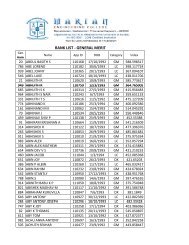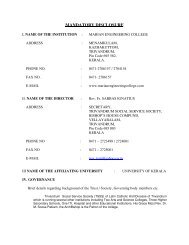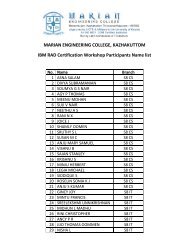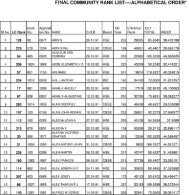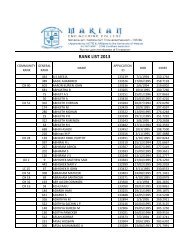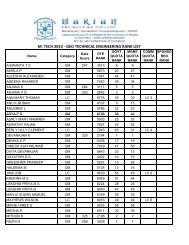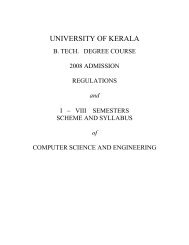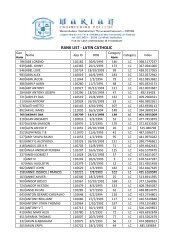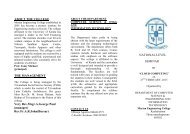UNIVERSITY OF KERALA - College of Engineering, Trivandrum
UNIVERSITY OF KERALA - College of Engineering, Trivandrum
UNIVERSITY OF KERALA - College of Engineering, Trivandrum
You also want an ePaper? Increase the reach of your titles
YUMPU automatically turns print PDFs into web optimized ePapers that Google loves.
08.806.5 Elective IV FINITE ELEMENTMETHODS<br />
L T P/D Cr<br />
3 0 0 3<br />
Module I<br />
Review <strong>of</strong> Matrix Structural Analysis (Direct Stiffness Method) –Element stiffness equations – Assembly <strong>of</strong><br />
elements – Node numbering to exploit matrix sparsity – Displacement boundary conditions.<br />
Basics <strong>of</strong> Elasticity – Strain Displacement relations – Constitutive relations. Introduction to FEM – outline <strong>of</strong><br />
procedure – Displacement Models & Polynomial interpolations – Equilibrium and compatibility in the solution -<br />
Convergence requirements.<br />
Potential energy <strong>of</strong> an elastic body - Principle <strong>of</strong> stationary potential energy – the Rayleigh – Ritz method –<br />
piecewise polynomial field – finite element form <strong>of</strong> Rayleigh-Ritz method - Weighted residual methods -shape<br />
functions for C0 and C1 elements –Lagrangian and Hermitian interpolation functions for one and two<br />
dimensional elements.<br />
Module II<br />
Displacement-based Elements for Structural Mechanics:- Formulas for element stiffness matrix and load vector<br />
– overview <strong>of</strong> element stiffness matrices – Consistent element nodal load vector - Lumped loads-Patch test - -<br />
Stress computation<br />
Developments <strong>of</strong> shape functions for truss, beam and frame elements- Constant strain triangle -Linear strain<br />
triangle -Bilinear plane rectangular elements.<br />
Module III<br />
Isoparametric formulation - Line element- Plane bilinear element- Isoparametric formulation <strong>of</strong> Quadratic plane<br />
elements - Subparametric elements and superparametric elements - Gauss quadrature<br />
Plate and shell elements. (Description only).<br />
Solution Techniques for Linear Algebraic Equations – Storage schemes.<br />
Discussion <strong>of</strong> Finite Element programs using ANSYS or NISA.<br />
References:<br />
1. Cook, R.D., ‘Concepts and Applications <strong>of</strong> Finite Element Analysis’, JohnWiley.<br />
2. .Krishnamoorthy, C.S., ‘Finite Element Analysis – Theory and Programming’, Tata Mc Graw Hill.<br />
3. Rajasekaran, S., ‘Finite Element Analysis in <strong>Engineering</strong> Design’, Wheeler Pub.<br />
4. .Bathe, K.J., ‘Finite Element Procedures in <strong>Engineering</strong> Analysis’, Prentice Hall <strong>of</strong> India<br />
5. Zienkiewicz, O.C., and Taylor, R.L., ‘The Finite Element Method’, Vol. I and II, Mc Graw Hill.<br />
6. .Desai, C.S., ‘Elementary Finite Element Method’, Prentice Hall <strong>of</strong> India.<br />
7. .Madhujit Mukhodhay., ‘Matrix & Finite Element Analysis <strong>of</strong> Structures’, Ane Books.<br />
Question paper:Duration: 3 hours<br />
The question paper consists <strong>of</strong> Part A and Part B.<br />
Part A is for 40 marks. There will be 8 compulsory short answer questions covering entire syllabus.<br />
Part B is for 60 marks. There will two questions from each module. The candidate has to answer one question<br />
<strong>of</strong> 20 marks from each module.<br />
Note: No charts, tables, codes are permitted in the Examination hall .If necessary relevant data shall be given<br />
along with the question paper by the question paper setter.<br />
99



